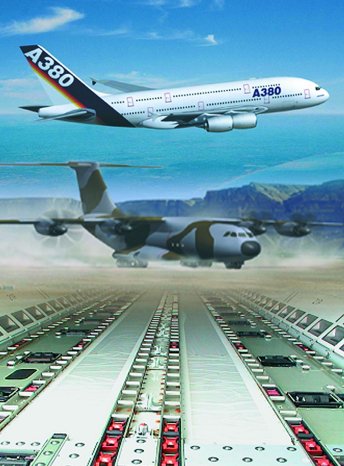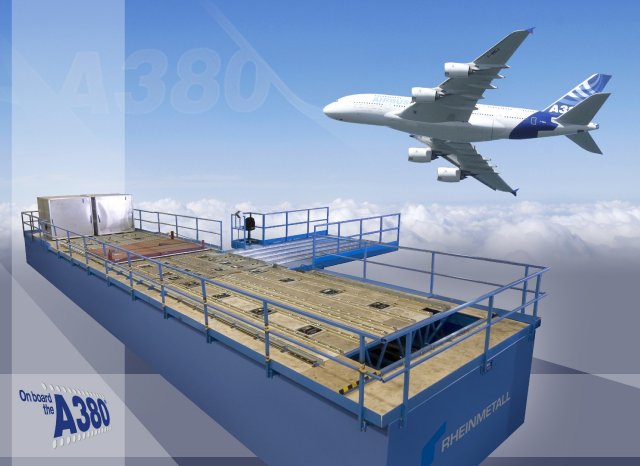Hunched over their electronic drawing boards, aircraft designers today are coming up with bigger and bigger planes in an effort to cope with burgeoning passenger numbers and cargo volumes. The latest high profile example is the new Airbus A380 passenger aircraft, the first of which have already entered service.
But there is no sense in thinking that large planes alone will be able to solve the problem of increased air traffic and the logistical challenges of globalization. The chaos that followed the opening of the new airport terminal at London's Heathrow in March 2008 shows how important reliable baggage logistics are to a smooth-running air transport operation - and what happens in their absence. "Because they make loading and unloading fast and safe, the sophisticated cargo loading systems found on board modern aircraft are a decisive factor in managing the growing number of passengers", says Stefan Makrinus, Vice President, Sales Cargo Loading and Aviation Systems, at Rheinmetall Defence in Bremen.
The company is active in three different segments of the market for cargo loading systems.
1. In passenger planes, the comfort of the travelling public is the prime concern. The cargo loading system in these planes - so-called lower deck systems - are located underneath the cabin, and play only a subsidiary role. This space is used primarily for stowing passenger baggage, with a mere 20 to 30% reserved for airfreight. "Highly sophisticated systems of the kind found in cargo planes are rarely used in passenger aircraft; what's most important here is that the system is robust, easy to operate and safe", declares Makrinus.
Lower deck systems from Rheinmetall Defence have enjoyed an excellent reputation for decades. Airbus was so impressed with the cargo loading system installed in series in the A340 that it ordered a very similar system for the A380.
Compared to the earlier version, however, the new system features a number of innovative features: for instance, it is linked to the on-board maintenance system in the cockpit, enabling the crew to control and monitor the plane's cargo hold. As a result, possible problems come to their attention even during the flight, meaning that appropriate measures can be taken after landing without delay. In addition, the pallets to be loaded can be turned automatically: the power drive units (PDUs) that move the containers and pallets are now equipped with two motors that make it possible to raise and lower the PDU units simultaneously, and to turn the rollers in order to move the load.
2. But it isn't just the volume of passenger traffic that's steadily rising: the number of cargo flights is too. Airfreight companies design their cargo bays to match their individual requirements - imposing heavy demands on cargo loading technology in the process. Thus a lot depends on having the best system in the business.
The requirements levied on these systems differ sharply from the type installed on board passenger aircraft. For one thing, the cargo holds are much larger; for another, more people are needed for the loading process.
Generally speaking, one loader remains near the cargo hatch, while two others operate on board, guiding the pallets to their intended location and locking them into place. From the engineering standpoint, these so-called main deck systems are more complex.
Especially in the cargo domain, change is afoot: and it's here that Stefan Makrinus sees the greatest business potential, particularly in the field of Pax-to-Freighter conversions, or PTF. The 39-year-old sales executive explains why: "After several years in service passenger planes no longer meet the latest standards in comfort, but this certainly doesn't mean you can't use them anymore. Though passengers obviously do, the cargo doesn't care how old a plane is. That's why just 20% of cargo planes are new aircraft; the rest spend the first part of their lives - 16 years or so - transporting passengers before being converted to carry cargo."
Whereas the Bremen-based system builder has been in the lower deck system business for decades, the common practice of PTF conversion involves a new three-pronged advance in the market: one in the main deck segment, another in the entirely new field of plane conversion, and finally, new access to Boeing platforms. In cooperation with Israel Aerospace Industries and America's Ancra International, Rheinmetall Defence has recently begun installing its system in the Boeing B747.
Since 2006 Rheinmetall Defence in Bremen has also been developing a Health Maintenance Display for this main deck system. Located in the cargo bay, the device displays all of the system components and their current status on a computer monitor. Thanks to a user-friendly menu - after all, loaders have to be able to operate it even at remote airfields - finding solutions to possible technical problems is quick and easy.
Moreover, help and advice are always at hand in the form of electronic operator manuals.
3. Globalization has also become the order of the day for many of the world's armed forces, which now have to fight and keep the peace in places that once would have seemed way beyond their operational reach. These farflung new commitments call for new means of transporting troops and materiel to remote areas of operation. For European armed forces, the Airbus A400M is destined to meet this need.
Owing to its success in the Airbus A340 and A380, the Bremen-based experts were also selected to develop a corresponding solution for Airbus's new military transport plane. The resulting cargo hold system has practically nothing in common with the lower deck and main deck cargo loading systems used in civilian aircraft.
"The cargo hold is the principal system in the A400M. It has to be able to handle a wide variety of missions, which in turn demands maximum flexibility", explains Makrinus. The plane has to be able to transport troops, supplies and heavy equipment, even infantry fighting vehicles. In addition, it will have to be able to airdrop supplies - whether by means of gravity extraction, i.e. dropping unsecured cargo by elevating the plane's nose with the cargo hatch open, or parachute extraction, in which case an unfurling parachute pulls the load out of the cargo hold. It could also be used as a flying field hospital, for instance, or for deploying airborne units.
At times, the cargo hold has to execute several missions at once or in rapid succession, delivering humanitarian aid on one run, for example, and paratroopers on another.
The nerve centre of the cargo hold is the loadmaster control system (LMC), consisting of the loadmaster workstation, the loadmaster control panel, eight sidewall lock panels and a remote control unit for operating the crane and winch. All of these support the loadmaster in carrying out his primary tasks. On the ground, he is responsible for loading and unloading, and adapting the cargo hold to match the mission; in the air, the loadmaster keeps track of everything not specifically related to the cockpit.
In addition to the loadmaster workstation (LMWS) in the forward section of the aircraft, there's also a loadmaster control panel near the ramp. Broadly speaking, everything the loadmaster can do with LMWS, he can also do with the control panel. In addition, he can use the remote control unit to operate the crane and winch, which are necessary for handling heavy loads. The A400M is the world's first aircraft to possess a system of this kind.
Everything from a single source: though Rheinmetall Defence began by manufacturing individual control elements for cargo loading systems, since the end of the 1990s it has been supplying entire systems. In the process, the company cooperates with German and international partners. This means that Rheinmetall is also capable of integrating components made by other manufacturers into its own systems, and can supply control modules for other company's systems. And a brief glance around the company's production facilities in Bremen reveals the level of technical sophistication this involves: a combination of cutting-edge components and unsurpassed expertise.
Newly developed components, system modifications and changes in the control software are meticulously scrutinized prior to use. Besides extensive testing in its own state-of-the-art laboratory and practical trials in the Rheinmetall A380 Test Rig (a replica cargo hold), all of the critical elements are tested in flight in a real-world environment. The company also conducted an in-service evaluation of the new A380 system on board a Lufthansa A340.
Every component is tested and qualified in accordance with the exacting requirements of the Germany Federal Aviation Bureau, the European Aviation Safety Agency (EASA) and the US Federal Aviation Administration (FAA).
Service too is written in capital letters at Rheinmetall's Bremen plant. If a problem arises in one of the systems, the company's laboratory analysts immediately attempt a remote diagnosis; if this doesn't work, a team of technicians flies out directly to the scene.
Rheinmetall Defence cargo loading systems have already been installed in a variety of different aircraft types. Some 150 of these high-tech systems are now in service worldwide, while individual Rheinmetall components are found in over 1,000 aircraft. In the next decade, this figure is set to increase many times over, with Rheinmetall technology appearing in a growing number of A380, A340, B747 and A400M planes.
Complex interplay - Cargo loading systems and their components
Cargo loading systems essentially consist of two elements. The mechanical elements are made up of rollers, latches and so-called "ballmats", which enable cargo to be easily shifted in any direction.
The other parts are electrical, and in turn fall into two separate categories: the control system and its various components, and the motors which move the cargo. These so called power drive units (PDUs) raise and lower the rollers that move the load to its destination.
The lower deck system that Rheinmetall Defence supplies for the Airbus A380 super jumbo offers a good example of the complex interplay between the different parts of a cargo loading system. The core element of the system is the compartment control box: installed near the cargo hatch, it controls and monitors the power supply to the other components, and checks control commands entered by the operator with the joystick on the outside or inside control panel; it also controls the PDUs in the ballmat area near the cargo door. The CCB communicates with the other components of the control system via a CAN bus network.
The sector control boxes embedded in the cargo compartment floor check and monitor the PDU systems and proximity switches. Located in the cargo hatch area, the specially developed door area control box enables communication between the cargo loading system and the on-board maintenance system (or OMS) for the first time.
The OMS connects every system on board the aircraft in a central computer. The loader can switch the system on and off, and move freight in the cargo hatch area with the help of the outside control panel. The inside control panel - installed in the ceiling panels of the ballmat area - makes it easier to move freight around the inside of the plane, especially in the rear area of the cargo hold.


